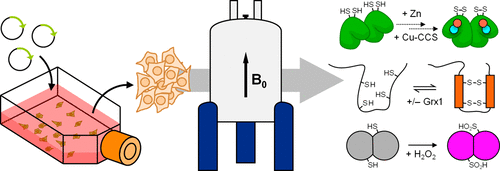03-Sep-2019
A recently developed scientific technique is allowing researchers at Instruct Centre IT to investigate proteins in their natural state. Traditional structural studies could only take place in vitro, which may result in improper protein folding and a lack of interactions with other stabilising ions and proteins. Since the environment inside the cell is critical for determining the final protein structure, to get the most accurate data, scientists need a way to study proteins that have been made by a human cell. As the name suggests, in-cell NMR allows scientists to study the molecular structure of a protein within a cell, and the team in Italy have used this new technique to investigate the changes in the SOD1 protein structure, which has been linked to amyotrophic lateral sclerosis, or ALS.

In cell-NMR in human cells (Acc. Chem. Res.20185161550-1557).
In-cell NMR has previously been applied to yeast and bacterial cells, but faces some significant challenges when it comes to using human cells. There are two main requirements of in-cell NMR: the protein must be labelled in some way so that scientists can identify it later, and it should also be present in high levels. In the past, proteins were pre-labelled and injected into a human cell. However, this meant that the 'added-extras' that determine the protein function were not always there.
Rather than directly injecting the protein, Dr Luchiant and Dr Banci have introduced DNA into the cell to code for the protein that they want to investigate. Then they grow the cells in a liquid that contains the labels, so that when the cell makes proteins it goes along the production line as usual, but uses the labelled nutrients from the liquid. The labels get incorporated into the protein, allowing scientists to identify the protein by NMR.
To make sure that there is enough protein to be detected by in-cell NMR, the researchers carefully chose which cells to use. Scientists in other areas of cell biology have created modified human embryonic kidney cells that are capable of high levels of protein production. Unlike normal human embryonic kidney cells, the modified cells are able to make a large number of proteins from the added DNA. This allows scientists to investigate any protein by adding the right DNA to the cells.
Dr Luchiant and Dr Banci’s lab started using their new technique by adding DNA that codes for the Superoxide Dismutase 1 protein, known as SOD1, to their cells. SOD1 has been linked to the degenerative disease ALS, and is known to bind a zinc and copper ion. Mutations to the DNA do not always change the function of this protein, but instead prevent it from folding properly, which causes the death of crucial nerve cells. Through their investigation, the team were able to pin-point the part of the cellular protein production line affected by different mutations in the DNA. The team hope that their new technique will help scientists to understand other diseases that involve mutations in protein production, allowing new treatments to be developed.
Find out more about NMR at Instruct-ERIC.
Read the full paper: Luchinat, E., et al. (2018). In-Cell NMR in Human Cells: Direct Protein Expression Allows Structural Studies of Protein Folding and Maturation. Accounts of Chemical Research, 51(6), 1550-1557.doi:10.1021/acs.accounts.8b00147